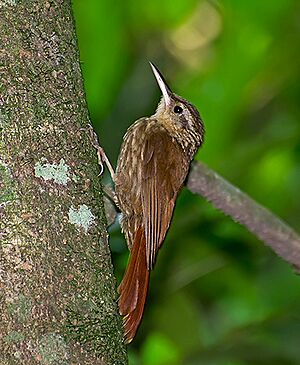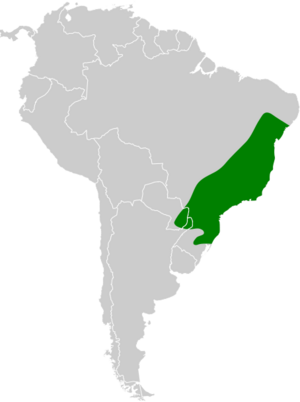Lesser woodcreeper facts for kids
The lesser woodcreeper (Xiphorhynchus fuscus) is a small bird that lives in parts of South America. It belongs to the ovenbird family, which is known for building unique nests. You can find this bird in countries like Argentina, Brazil, and Paraguay.
Quick facts for kids Lesser woodcreeper |
|
|---|---|
 |
|
| Conservation status | |
| Scientific classification | |
| Genus: |
Xiphorhynchus
|
| Species: |
fuscus
|
 |
|
| Synonyms | |
|
Lepidocolaptes fuscus (Vieillot, 1818) |
|
Contents
About the Lesser Woodcreeper's Name
Scientists group living things into families and types. The lesser woodcreeper's scientific name is Xiphorhynchus fuscus. For a while, it was placed in a different group called Lepidocolaptes. But since the late 1990s, experts agreed it fits better in the Xiphorhynchus group.
There are three slightly different kinds, or subspecies, of the lesser woodcreeper:
- X. f. fuscus
- X. f. pintoi
- X. f. tenuirostris
Another bird, the Ceara woodcreeper, used to be thought of as a subspecies of the lesser woodcreeper. However, scientists now consider it a separate species.
What Does the Lesser Woodcreeper Look Like?
The lesser woodcreeper is a small, slender bird. It has a long, thin bill that curves slightly downwards. These birds are about 15 to 18.5 centimeters (6 to 7.3 inches) long. They weigh between 15.5 and 25 grams (0.5 to 0.9 ounces). Both male and female birds look the same.
Their face is mostly dark, with a wide, creamy-yellow stripe above their eye. The top of their head and back of their neck are dark brown. They have small yellowish spots on their head that turn into streaks on their neck. Their back and wing feathers are olive-brown to reddish-brown. Their flight feathers and tail are a reddish-chestnut color.
Their throat is plain creamy yellow. Their chest and belly are smoky brown with bold, dark-edged spots. The feathers under their tail and wings are cinnamon colored. Their eyes are dark brown. Their bill is dark brown on top and pinkish-white underneath. Their legs and feet are olive-gray to bluish-gray. Young birds look similar to adults but have lighter spots on their undersides.
The subspecies X. f. tenuirostris is a bit bigger than the main type. Its spots are paler. The X. f. pintoi subspecies is lighter overall. It has more yellow on its belly and more cinnamon on its wings and tail.
Where Do Lesser Woodcreepers Live?
The most common type of lesser woodcreeper, X. f. fuscus, lives in many places. You can find it in southeastern Brazil, southern Paraguay, and Argentina's Misiones Province. The X. f. tenuirostris subspecies lives along the coast of eastern Brazil. The X. f. pintoi subspecies is found in western Brazil.
These birds live in many kinds of forests. They prefer lowland rainforests and humid mountain forests. In drier areas, they live in semi-deciduous forests and forests along rivers. In the south, they live in forests with many Araucaria trees. They like the inside and edges of old, untouched forests. They can also be found in older regrown forests. Sometimes, they are seen in younger forests or open areas near forests. They usually live below 1,200 meters (3,900 feet) in elevation. However, they can be found as high as 1,500 meters (4,900 feet) or even higher.
Lesser Woodcreeper Behavior
Movement
Lesser woodcreepers are thought to stay in the same area all year round. However, sometimes their numbers change in southern Brazil. This might mean they move short distances locally.
Feeding Habits
The lesser woodcreeper mainly eats arthropods, which are creatures like insects and spiders. It might even eat only these types of animals. It often forages alone, but it also joins groups of different bird species to find food. Less often, it follows swarms of army ants.
It mostly looks for food on tree trunks and branches. It usually searches from the lower parts of the forest up to the middle levels. Sometimes, it goes all the way to the top of the trees. It prefers trees with rough bark, especially if they have moss. It often finds food in dead leaves and dead bromeliad plants. It usually picks prey off trees while perched. Sometimes, it flies out from a perch to catch an insect in the air.
Life Cycle and Reproduction
The breeding season for the lesser woodcreeper is thought to be from September to December. These birds build their nests inside tree cavities. One nest that was studied was in a natural crack in a tree. It was lined with dried leaves and pieces of bark. A female bird usually lays two eggs, but sometimes three. Scientists do not know how long the eggs take to hatch. They also don't know how long it takes for the young birds to leave the nest. It seems that only the female bird sits on the eggs.
Vocalization
The lesser woodcreeper's song is a fast, sharp rattling sound. It often stutters at the end. The most common subspecies' song also stutters at the beginning. People have described its song as "chit, chit, chit, chee-ee-ee-ee-ee-ee-ee, chit, chit-chit." Its calls include a very high, sharp "fieet fieet." It also makes doubled "peep, peesp" sounds and single "speel" or "wik" sounds.
Conservation Status
The IUCN (International Union for Conservation of Nature) has listed the lesser woodcreeper as a species of "Least Concern." This means it is not currently in danger of disappearing. It lives across a large area. However, its total population size is not known. Scientists believe its numbers are decreasing. No immediate threats have been found.
It is quite common in most parts of Brazil where it lives. But it is less common in Rio Grande do Sul, Paraguay, and Argentina. Some people think it is very sensitive to human activity. However, it can still live in moderate numbers in forests that have been partly logged. It can also survive in tall regrown forests and medium-sized forest patches.


